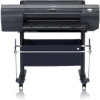Canon imagePROGRAF iPF6350 iPF6300/iPF6350 Basic Guide No.2 - Page 11
Adj Far Ed Feed
 |
View all Canon imagePROGRAF iPF6350 manuals
Add to My Manuals
Save this manual to your list of manuals |
Page 11 highlights
Phenomenon Colors in printed images are uneven Troubleshooting Cause Corrective Action Line Drawing/Text is selected In Print Priority in the Advanced Settings of the when printing images in many solid printer driver, choose Image. colors. You are printing on paper that curls Printed colors may appear uneven on the leading easily. edge of paper that is susceptible to curling. Select a stronger level in VacuumStrngth in the Control Panel menu to increase suction against the paper, or specify a leading margin of 20 mm (0.79 in) or more. (→"Adjusting the Vacuum Strength (VacuumStrngth)," User Manual) Printed colors may be uneven if you set the Print Quality too low. Choose a higher level of Print Quality in the Advanced Settings of the printer driver. Printing in Draft or Standard mode is faster and consumes less ink than in Highest or High modes, but the printing quality is lower. (→"Giving Priority to Particular Graphic Elements and Colors for Printing," User Manual) Color may be uneven between dark and light image areas. Select Unidirectional Printing in the Advanced Settings of the printer driver. When borderless printing is used, the edge of the paper is cut during printing. Thus, ink density may be slightly uneven at the edges. Specify No in Auto Cut in the printer driver before printing. In this case, the paper can be printed without borders on the left and right sides only. Cut the printed document ejected from the printer, and then use scissors or a cutting tool to cut away the edges on the top and bottom. Choose a higher level of Print Quality in the Advanced Settings of the printer driver. (→"Giving Priority to Particular Graphic Elements and Colors for Printing," User Manual) The Printhead is out of alignment. Adjust the Printhead alignment. (→ , If Vertical Lines are Warped or Colors are Misaligned) Allowing printed documents to dry To avoid uneven colors, we recommend drying each on top of each other may cause sheet separately. uneven colors. Density may be uneven if you use In Advanced Settings of the printer driver, choose Glossy Paper or Coated Paper. Highest or High in Print Quality. The type of paper specified in the printer driver does not match the type loaded in the printer. Load paper of the same type as you have specified in the printer driver. (→ , Loading Rolls in the Printer) (→ , Loading Sheets in the Printer) Make sure the same type of paper is specified in the printer driver as you have loaded in the printer. 1. Press the Stop button and stop printing. 2. Change the type of paper in the printer driver and try printing again. Colors may be uneven at the trailing edge when you print on heavyweight sheets even if you execute Adj Far Ed Feed. For heavyweight sheets or similar paper, execute Adj Far Ed Feed with the Front Tray Guides raised. Also keep the Front Tray Guides raised during printing. Lower the Front Tray Guides when printing on paper other than heavyweight sheets. 11















